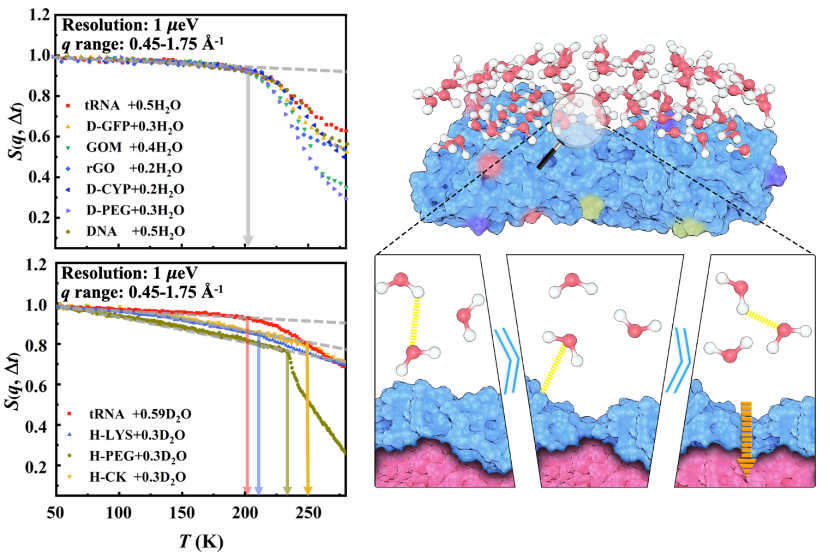
近日,beat365中文版官方网站自然科学研究院/beat365中文版官方网站洪亮课题组联合中国科学院福建物质结构研究所庄巍课题组,东莞散裂中子源程贺课题组利用中子散射、氘化技术和分子动力学模拟,在不同蛋白质、DNA、RNA乃至普通高分子等材料上,原位研究界面水分子的动力学行为与体系的动力学转变的关系。该工作发现,对于完全迥异的材料体系,其动力学转变均由界面水分子特有的氢键交换所驱使。研究成果以“Universal Dynamical Onset in Water at Distinct Material Interfaces”为题发表在英国皇家化学学会(Royal Society of Chemistry)的旗舰期刊Chemical Science (影响因子: 9.825; DOI: 10.1039/D1SC04650K)上。
生物保存是涉及从生物大分子(蛋白,DNA,RNA等)到细胞乃至活体器官长期存储和运输的关键工程问题。当外界温度降低至大约-70 ℃时,生物大分子会从柔软的功能态被冻结到无功能的非晶固态,该现象被称为动力学转变。这也解释了为什么生物实验室往往使用-80 ℃的冰箱,这样生物样品被冻结在动力学转变温度以下成为非晶固体,从而实现长期保存。在工程应用中为了降低生物保存对低温的依赖性,可以通过添加生物保存剂(例如甘油,海藻糖,蔗糖等)来提高保存温度,从而降低储存和运输成本。比如辉瑞公司的新冠疫苗初始生物保存策略为通过添加蔗糖将mRNA疫苗在-60 ℃进行保存。又比如一般的蛋白质类药物或核酸检测关键酶可以在蔗糖、海藻糖、甘油等保护剂作用下于-20 ℃乃至室温长期保存。通过保护剂的添加提高保存温度能够大大降低生物保存对冷链的依赖。因此,研究生物体系(蛋白,RNA,DNA,细胞,器官等)的低温动力学转变微观机制以及研发具有优异的生物相容性、保存温度接近室温的保护剂,不仅是重要的科学问题,也有重要的工程意义。
本工作结合氘化技术和准弹性中子散射实验研究了低温下近10种不同生物分子和软物质材料界面水分子的运动行为,以及其对温度的依赖性。团队发现虽然不同材料界面的化学、物理、形貌特征迥异,但其表面的结合水分子都会在-70 ℃左右发生动力学转变。进一步的实验分析发现该转变是由水分子的一种特有的跨能垒(35 kJ/mol)运动造成的。团队通过对多个体系的全原子分子动力学模拟揭示界面水分子微观运动图像,发现该特有的不依赖界面的跨能垒运动是相邻两个水分子氢键交换过程。与此同时,水分子将这一运动的自由度通过静电相互作用传递给被其包裹的生物大分子或者软物质材料,从而激发后者的柔性,并开启其功能。换句话说,生物及软物质材料界面近邻水分子之间的氢键交换过程是界面水分子的特有性质,其能垒与特征运动时间不依赖于界面材料。但该过程却是激发生物及软物质材料柔性的能量来源,导致后者的动力学转变,并很大程度决定了体系低温保存的特征温度。本工作不仅揭示了动力学转变这一普遍存在于生物体系的生物物理现象背后的一般性规律,也为研发新型生物低温保存剂提供了新思路。即通过改变溶剂分子的化学结构,来调节近邻溶剂分子的氢键作用,从而优化并提高保存温度,降低生物体系储存和运输成本。

beat365中文版官方网站beat365中文版官方网站博士生郑力荣为本文第一作者,自然科学研究院助理研究员刘卓,内蒙古民族大学教授张强为共同第一作者;洪亮教授为通讯作者,中国科学院福建物质结构研究所庄巍教授与东莞散裂源程贺研究员为共同通讯作者。该工作得到了国家自然科学基金委、上海市科委、教委以及上海人工智能国家实验室的支持,以及谱仪科学家Madhusudan Tyagi(美国国家技术标准局),Victoria García Sakai(英国ISIS中子源)和Takeshi Yamada(日本J-Parc中子源)的技术支撑。
Bio-preservation is a key engineering process, crucial for the long-term storage and transportation of biomacromolecules (proteins, DNA, RNA, etc.), cells and living organs. Biomacromolecules exhibit a dynamical transition around -70 ℃, across which they transform from a rigid, harmonic state, to a flexible, anharmonic state. This transition is of direct connection to the functional onset of various biomacromolecules. The amorphous rigid state of biological systems below dynamical transition temperature can be stored for a long time, which rationalizes why the -80 ℃ Fridge are often used in various biological laboratories. In order to reduce the harsh requirement of cold chain on the biopreservation, one can add bio-compatible preservation agents (such as glycerol, trehalose, sucrose, etc.) in to the system to increase the preservation temperature. Therefore, the costs of storage and transportation can be reduced. For example, the initial biological preservation strategy of Pfizer's COVID-19 vaccine is to store mRNA at -60 ℃ by adding sucrose. Besides, protein drugs or key enzymes for nucleic acid detection can be stored for a long time at -20 ℃ or even room temperature by adding protective agents like sucrose, trehalose and glycerol etc. Increasing the storage temperature by adding the protective agents can significantly reduce the dependence of biological storage and transportation on the cold chain. Hence, studying of the microscopic mechanism underlying the dynamical transition and searching for the proper bio-preservation agent is not only of scientifically important but also of great engineering significance.
On Mar. 28th, 2022, Chemical Science, the flagship journal of Royal Society of Chemistry, published a new edge research article on the dynamics of interfacial water at distinct materials entitled as “Universal Dynamical Onset in Water at Distinct Material Interfaces” by Prof. Liang Hong’s group (Institute of Natural Sciences/School of physics and astronomy), Prof. Wei Zhuang’ group (Fujian Institute of Research on the Structure of Matter, Chinese Academy of Sciences) and Prof. He Cheng’ group (Dongguan Institute of Neutron Science) (DOI: 10.1039/D1SC04650K).
In the present work, the research group experimentally examined the temperature dependence of the dynamics of non-freezing interfacial water at subzero temperatures across a wide range of materials with drastically different chemical composition, structures and packing. In all the systems studied herein, the water molecules present a universal dynamical onset whose characteristic onset temperature is independent of the surface nature of the underlying materials as well as the level of hydration, but varies with the resolution of the neutron spectrometer used. The group provided the extensive experimental evidence over many different materials that the dynamical onset of interfacial water is an intrinsic property of water itself, resulting from a surface independent relaxation process in water with an approximately universal energy barrier of ~35 kJ/mol. Complementary computer simulations confirmed the experimental findings and revealed that this intrinsic relaxation corresponds to the switching of hydrogen bond between neighboring hydration water molecules. Moreover, they found that, although the fast relaxation of the materials has the same energy barrier as its surface water, its rate is strongly dependent on their structure, packing and interaction with the surface water. The latter leads to system-dependent dynamical onsets and different flexibilities at low temperatures, which could be crucial for their functions at subzero temperatures. More importantly, this work not only reveals the general mechanisms behind the dynamic transitions that prevail in biological systems, but also provides new strategy for the development of new biological cryo-preservations: tuning the chemical structure of the preservation agent to change the dynamics of hydrogen bonds between solvent molecules and then to optimize the preservation temperature.
This is a collaborative work by Prof. Liang Hong at SJTU, Prof. Wei Zhuang at Fujian Institute of Research on the Structure of Matter and Prof. He Cheng at China Spallation Neutron Source. The first author is Mr. Lirong Zheng, the PhD student in Liang’s group. The work was supported National Natural Science Foundation of China and Shanghai Municipal Scienwce and Technology Major Project. The beam time was supported by Madhusudan Tyagi from NIST (US), Victoria García Sakai from ISIS (UK) and Takeshi Yamada from J-Parc (Japan).




